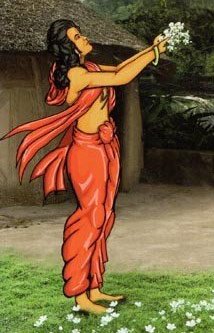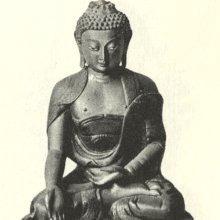Pradyota, Prādyota: 15 definitions
Introduction:
Pradyota means something in Hinduism, Sanskrit. If you want to know the exact meaning, history, etymology or English translation of this term then check out the descriptions on this page. Add your comment or reference to a book if you want to contribute to this summary article.
Images (photo gallery)
In Hinduism
Purana and Itihasa (epic history)
Source: archive.org: Puranic Encyclopedia1) Pradyota (प्रद्योत).—A Yakṣa. He was a member of the court of Kubera. (Śloka 15, Chapter 10, Śānti Parva).
2) Pradyota (प्रद्योत).—The first king of the dynasty of Pradyota. He was the son of a king called Śunaka. Pradyota is referred to as Śunakaputra in Vāyu Purāṇa. Kṣemaka alias Śunaka father of Pradyota was killed by Mlecchas (a barbarous tribe). To avenge the death of his father Pradyota under the advice of Nārada decided to conduct a Mleccha Yajña and for that purpose dug a Yajñakuṇḍa seventeen miles long and seventeen miles wide. The Yajña started and in that Yajṅa different kinds of Mlecchas were burnt to death. From then onwards Pradyumna got the name 'Mlecchahantā' (killer of Mlecchas). (Bhaviṣya Purāṇa).
Source: Cologne Digital Sanskrit Dictionaries: The Purana Index1a) Pradyota (प्रद्योत).—A son of Śunaka, the minister of Purañjaya; when Purañjaya was killed by Śunaka, Pradyota became king; father of Pālaka; founder of the line of Pradyotanas, five in number and who ruled for 138 years.*
- * Bhāgavata-purāṇa XII. 1. 3-4.
1b) A Yakṣa; a son of Puṇyajani and Maṇibhadra.*
- * Brahmāṇḍa-purāṇa III. 7. 124; Vāyu-purāṇa 69. 156.
1c) The son of Munika, killed his master Ripumjaya and ruled for 23 years; a Praṇatasāmanta, his four successors ruled for 138 years; Śiśunāka slew him and became king. Father of Balāka.*
- * Vāyu-purāṇa 99. 310-4; Viṣṇu-purāṇa IV. 24. 2-3.
2) Prādyota (प्राद्योत).—Five kings from Pradyota to Nandivardhana; ruled for 138 years.*
- * Brahmāṇḍa-purāṇa III. 74. 127.

The Purana (पुराण, purāṇas) refers to Sanskrit literature preserving ancient India’s vast cultural history, including historical legends, religious ceremonies, various arts and sciences. The eighteen mahapuranas total over 400,000 shlokas (metrical couplets) and date to at least several centuries BCE.
Kavya (poetry)
Source: Wisdom Library: KathāsaritsāgaraPradyota (प्रद्योत) is the name of the king of Magadha who opposed king Udayana, according to the Kathāsaritsāgara, chapter 15. His daughter is named Padmāvatī and their story is told by Yaugandharāyaṇa to Rumaṇvat.
The Kathāsaritsāgara (‘ocean of streams of story’), mentioning Pradyota, is a famous Sanskrit epic story revolving around prince Naravāhanadatta and his quest to become the emperor of the vidyādharas (celestial beings). The work is said to have been an adaptation of Guṇāḍhya’s Bṛhatkathā consisting of 100,000 verses, which in turn is part of a larger work containing 700,000 verses.

Kavya (काव्य, kavya) refers to Sanskrit poetry, a popular ancient Indian tradition of literature. There have been many Sanskrit poets over the ages, hailing from ancient India and beyond. This topic includes mahakavya, or ‘epic poetry’ and natya, or ‘dramatic poetry’.
Yoga (school of philosophy)
Source: ORA: Amanaska (king of all yogas): A Critical Edition and Annotated Translation by Jason BirchPradyota (प्रद्योत) or Pradyotamāna refers to “shining (in every direction)”, according to the Pātañjalayogaśāstra (1.2).—Accordingly, “[...] [When] its covering of delusion is destroyed and, shining in every direction (pradyotamāna), it is penetrated by only Rajas, the [mind] becomes capable of religious activity, wisdom, detachment and power. [When] free from the impurity of [even] a slight trace of Rajas and established in its own essence, [and when it consists of] merely the perception of the otherness of Spirit from Sattva, the [mind] becomes capable of meditation on Dharmamegha”.

Yoga is originally considered a branch of Hindu philosophy (astika), but both ancient and modern Yoga combine the physical, mental and spiritual. Yoga teaches various physical techniques also known as āsanas (postures), used for various purposes (eg., meditation, contemplation, relaxation).
Languages of India and abroad
Sanskrit dictionary
Source: DDSA: The practical Sanskrit-English dictionaryPradyota (प्रद्योत).—
1) Irradiating, lighting, illuminating.
2) Splendour, light, lustre.
3) A ray of light.
4) Name of a king of Ujjayinī, whose daughter Vatsa married; प्रद्योतस्य प्रियदुहितरं वत्सराजोऽत्र जह्रे (pradyotasya priyaduhitaraṃ vatsarājo'tra jahre) Meghadūta 32. (considered as an interpolation by Malli.); Ratnāvalī 1.1.
Derivable forms: pradyotaḥ (प्रद्योतः).
Source: Cologne Digital Sanskrit Dictionaries: Edgerton Buddhist Hybrid Sanskrit DictionaryPradyota (प्रद्योत).—(1) name of a large group of former Buddhas: (8,000) Mahāvastu i.58.3, (60,000) 61.12; (2) name of a future Buddha: Mahāvastu ii.355.2 = iii.279.7; Gaṇḍavyūha 441.25 (see s.v. Maitreya).
Source: Cologne Digital Sanskrit Dictionaries: Shabda-Sagara Sanskrit-English DictionaryPradyota (प्रद्योत).—m.
(-taḥ) 1. A ray of light. 2. Light, lustre. 3. Lighting, illumining. 4. The name of a king of Ujjayini but considered to be spurious by Mallinatha. E. pra excess, and dyota shining.
Source: Cologne Digital Sanskrit Dictionaries: Benfey Sanskrit-English DictionaryPradyota (प्रद्योत).—[pra-dyota], m. 1. A ray of light. 2. Light.
Source: Cologne Digital Sanskrit Dictionaries: Cappeller Sanskrit-English DictionaryPradyota (प्रद्योत).—[masculine] flashing up, light, splendour; [Name] of a Yakṣa & [several] kings.
Source: Cologne Digital Sanskrit Dictionaries: Monier-Williams Sanskrit-English Dictionary1) Pradyota (प्रद्योत):—[=pra-dyota] [from pra-dyut] m. radiance, light, [Śatapatha-brāhmaṇa]
2) [v.s. ...] a ray of l°, [cf. Lexicographers, esp. such as amarasiṃha, halāyudha, hemacandra, etc.]
3) [v.s. ...] Name of a Yakṣa, [Mahābhārata]
4) [v.s. ...] of a king of Magadha and founder of a dynasty, [Viṣṇu-purāṇa; Kathāsaritsāgara]
5) [v.s. ...] of a king of Ujjayinī and other princes, [Lalita-vistara]
6) [v.s. ...] Priyad, [Bhāgavata-purāṇa]
Source: Cologne Digital Sanskrit Dictionaries: Yates Sanskrit-English DictionaryPradyota (प्रद्योत):—[pra-dyota] (taḥ) 1. m. A ray of light; lustre, light.
Source: DDSA: Paia-sadda-mahannavo; a comprehensive Prakrit Hindi dictionary (S)Pradyota (प्रद्योत) in the Sanskrit language is related to the Prakrit words: Pajjoa, Pajjoya.
[Sanskrit to German]
Sanskrit, also spelled संस्कृतम् (saṃskṛtam), is an ancient language of India commonly seen as the grandmother of the Indo-European language family (even English!). Closely allied with Prakrit and Pali, Sanskrit is more exhaustive in both grammar and terms and has the most extensive collection of literature in the world, greatly surpassing its sister-languages Greek and Latin.
Kannada-English dictionary
Source: Alar: Kannada-English corpusPradyōta (ಪ್ರದ್ಯೋತ):—
1) [noun] a ray of light.
2) [noun] radiance; light.
Kannada is a Dravidian language (as opposed to the Indo-European language family) mainly spoken in the southwestern region of India.
See also (Relevant definitions)
Starts with: Pradyotabhupa, Pradyotabhupakatha, Pradyotama, Pradyotamana, Pradyotana, Pradyotana bhattacarya, Pradyotanasuri.
Ends with: Candapradyota, Chandapradyota, Katantraparishishtapradyota, Paksha-pradyota.
Full-text (+22): Pradyoti, Nalagiri, Candapradyota, Pradyotin, Pradyotana, Brihadratha, Paksha-pradyota, Jaghanyaja, Shishunaga, Pradyotita, Shunaka, Pajjoya, Pajjoa, Vishakhayupa, Virahantra, Ajaka, Vasavadatta, Padmavati, Munika, Ketu.
Relevant text
Search found 23 books and stories containing Pradyota, Pra-dyota, Prādyota, Pradyōta; (plurals include: Pradyotas, dyotas, Prādyotas, Pradyōtas). You can also click to the full overview containing English textual excerpts. Below are direct links for the most relevant articles:
The Bhagavata Purana (by G. V. Tagare)
Chapter 1 - Dynasties of the Kali Age < [Book 12 - Twelfth Skandha]
A Historical Study of Kaushambi (by Nirja Sharma)
Political History of Vatsa < [Chapter 2]
Historical Background of Kaushambi < [Chapter 2]
The Buddhist Tradition < [Chapter 2]
Trishashti Shalaka Purusha Caritra (by Helen M. Johnson)
Part 10: Story of Devadattā and Pradyota < [Chapter XI - The story of Rauhiṇeya]
Part 4: Continuation of Abhaya and Pradyota story < [Chapter XI - The story of Rauhiṇeya]
Part 4: Mṛgāvatī and Pradyota < [Chapter VIII - Initiation of ṛṣabhadatta and devānandā]
The Matsya Purana (critical study) (by Kushal Kalita)
Part 2.2a - The Magadha Dynasty < [Chapter 3 - Historical aspects in the Matsyapurāṇa]
Part 2.2b - The Paurava Dynasty < [Chapter 3 - Historical aspects in the Matsyapurāṇa]
Part 2.1a - The Solar Dynasty < [Chapter 3 - Historical aspects in the Matsyapurāṇa]
Sahitya-kaumudi by Baladeva Vidyabhushana (by Gaurapada Dāsa)
Text 2.19 < [Chapter 2 - The Natures of Words (śabda)]
Garga Samhita (English) (by Danavir Goswami)
Verse 8.13.113 < [Chapter 13 - A Thousand Names of Lord Balarāma]
